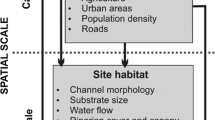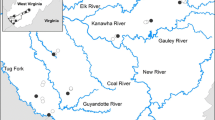Abstract.
This study addressed potential land use impacts to macroinvertebrate communities and water quality from past coal mining activities in the watershed of the North Branch of the Susquehanna River (located in northeastern Pennsylvania and southern New York). Landscape tools of GIS and remote sensing (RS) were used to calculate percent land cover (forest, agriculture, barren, urban, and water) from SPOT imagery (for tributaries) and Multi-Resolution Land Characteristics (MRLC) data (for river sites) on 17 subcatchments in the study area. The study design included field sampling at reach locations at four first- and second-order sites with low urban and low barren (mining) land cover, four similar sized sites with high mining and high barren land cover, five sites with intermediate combinations of urban and barren, and four mainstem river sites (60% forest and 35% agriculture). Sites were sampled in early fall for macroinvertebrates (17 parameters, e. g., EPT richness, percent filterers), benthic substrates (including deposits from mine waters), and 10 water chemistry parameters. A principal component analysis (PCA) on the macroinvertebrate parameters provided plot-clustering of subcatchments based generally on the above study design groupings; river sites clustered closer to smaller streams with low mining and urban land cover. Correlations identified six macroinvertebrate parameters (e. g., EPT richness, collector-gatherers) best associated with the three major axes of the PCA; each of these six indicators was analyzed in step-wise multiple regressions as dependent variables against land cover, benthic substrate, and water chemistry parameters. The strongest regressions were for percent barren land cover that explained the greatest amount of variation in both EPT richness and taxa richness. This mining affect was confirmed with dissolved iron and sulfate concentrations and levels of sedimentation and iron deposition explaining variability across several macroinvertebrate parameters. Comparison to the published literature on mining impacts indicated advantages to using a GIS watershed approach in multivariate analyses of stream ecosystem response. Also, this appears to be the first GIS watershed assessment of mining land use affects since most published studies of land use impacts to watersheds and lotic ecosystems have focused on either agriculture or urbanization.
Similar content being viewed by others
Author information
Authors and Affiliations
Corresponding author
Additional information
Received: 14 December 2004; revised manuscript accepted: 30 May 2005
Rights and permissions
About this article
Cite this article
Bruns, D.A. Macroinvertebrate response to land cover, habitat, and water chemistry in a mining-impacted river ecosystem: A GIS watershed analysis. Aquat. Sci. 67, 403–423 (2005). https://doi.org/10.1007/s00027-005-0792-3
Published:
Issue Date:
DOI: https://doi.org/10.1007/s00027-005-0792-3




